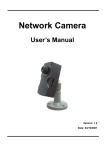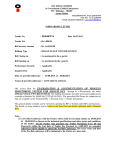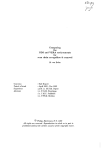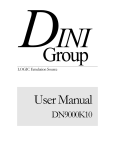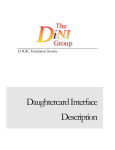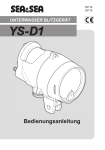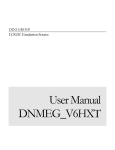Download User Manual for DVI
Transcript
THE DINI GROUP DVI DAUGHTER CARD - PROVISIONAL User Guide DNMEG_DVI PROVISIONAL NOT COMPLETE – SEE SCHEMATIC FOR DETAILS LOGIC EMULATION SOURCE DNMEG_DVI User Manual Version 1.2 The Dini Group 7469 Draper Ave. La Jolla, CA92037 Phone 858.454.3419 • Fax 858.454.1728 [email protected] www.dinigroup.com Last Modified: 8/3/2009 12:35:27 Last saved by bpoladian 0 Chapter Welcome to DNMEG_DVI Daughter Card : r1 te p a h C Congratulations on your purchase of the DNMEG_DVI Daughter Card! Q U I C K S T A R T 1 Chapter G U I D E 1 Quick Start Guide The Dini Group DNMEG_DVI is the user-friendliest board available with a Virtex 4 FPGA and two DVI interfaces 1.1 What’s provided First, let‟s examine the contents of your DNMEG_DVI kit. It should contain: DNMEG_DVI board RS 232 IDC header cable to female DB9 CD ROM containing: o Virtex 4 Reference Design [Note: update to follow] o User manual PDF [Note: update to follow] o Board Schematic PDF o DNMEG_DVI firmware [Note: update to follow] DNMEG_DVI User Guide www.dinigroup.com 3 D N M E G _ D V I The Dini Group can optionally provide the following accessories: Memory modules for use in the DNMEG_DVI DDR2 SODIMM socket - QDRII SRAM 64x1Mb, 300Mhz - Flash memory 32x4Mb, 2x4Mb serial flash - Reduced Latency DRAM (RLDRAM) 64x8Mb, 300Mhz - Standard SRAM, 64x2M (Select ZBT/sync-burst, Pipelined/Flow through) - Test connection module (with two Mictor38) - Or any of the SODIMM modules listed on the Dini Group website. You may also want to obtain from a third party vendor: Xilinx Parallel Cable IV or Xilinx Platform Cable USB 200-pin DDR2 SODIMM Xilinx Chipscope for embedded logic analyzer functionality. LCD monitor with DVI input [Any DVI 1.0 compliant monitor should suffice]. Video card with DVI output. Video camera with DVI output. 1.2 Precaution The DNMEG_DVI is sensitive to static electricity, so treat the PCB accordingly. The target markets for this product are engineers who are familiar with FPGAs and circuit boards. However, if needed, the following web page has an excellent tutorial on the “Fundamentals of ESD” for those of you who are new to ESD sensitive products: http://www.esda.org/basics/part1.cfm There are four ground test points on the DNMEG_DVI The DNMEG_DVI has been factory tested and pre-programmed to ensure correct operation. You do not need to alter any jumpers or program anything to see the board work. A reference design is included on the provided CD. The 400-pin connector is not 5V tolerant. According to the Virtex 4 datasheets, the maximum applied voltage to these signals is VCCO + 0.5V (3.0V while powered on). These connections are not buffered, and the Virtex 4 part is sensitive to ESD. Take care when handling the board to avoid touching the daughter card connectors. DNMEG_DVI User Guide www.dinigroup.com 4 D N M E G _ D V I 1.3 Power-On Instructions The image below represents your DNMEG_DVI. You will need to know the location of the following parts referenced in this chapter. DNMEG_DVI User Guide www.dinigroup.com 5 D N M E G _ D V I To begin working with the DNMEG_DVI, follow the steps below: 1.4 Verify Switch Settings The DNMEG_DVI uses a DIP switch to program the FPGA configuration circuitry. The function of these DIP switches is listed in Table 2. Verify that the switch settings on your board match the default settings. Table 1 - Switch Description Switch Default Position Signal Name On setting Off setting S1-1 Off CFG_REV0 S1-2 Off S1-3 Off When CFG_REVSEL is ON - CFG_REV0 and CFG_REV1 are used to select the design CFG_REV1 revision to be enabled, overriding the internal CFG_REVSEL programmable revision selection control bits. S1-4 Off DIPSW4 Configurable Configurable 1.5 Memory and heat sinks There should be an active heat sink installed on the FPGA on the DNMEG_DVI. Virtex 4 FPGAs are capable of dissipating 15W or more, so you should always run the board with the heat sink installed. The DNMEG_DVI comes packaged without memory installed. If you want the Dini Group reference design to test your memory module, you can install it now in the 1.8V DDR2 DIMM socket. The socket DDR2_SODIMM can accept any capacity DDR2 SODIMM. Note that DDR1 modules will not work in these slots since they are supplied with 1.8V power and DDR1 requires 2.5V power (and a completely different pin-out). [Note that the Dini Group has a DDR2 module that provides a DDR1 socket, even so, changing all the voltages would still be required. In the DNMEG_DVI this is a jumper setting on H9.] DNMEG_DVI User Guide www.dinigroup.com 6 D N M E G _ D V I 1.6 Power Up Procedure 1. Plug the four pin hard drive power connector from the power supply into P2. Make sure your work area is clear and there are no metal wrenches under the board. Turn on the power supply. When the DNMEG_DVI powers on, it automatically loads Xilinx FPGA design bit file stored in the PROM (if the load FPGA option was selected during PROM programming). To load a different Xilinx bit program file into the DNMEG_DVI follow the steps outlined in section 2.4. 1.7 Loading FPGA configuration once The DNMEG_DVI reads FPGA configuration data from the JTAG chain. To program the FPGA on the DNMEG_DVI, FPGA design file (with a .bit file extension) are uploaded through the JTAG chain. This can be accomplished using the Xilinx ISE iMPACT tool. Step by step instructions for loading bit file into the FPGA via iMPACT. 1. Attach the Xilinx JTAG cable to J8 on the DNMEG_DVI 2. Start iMPACT. 3. Create a new project in iMPACT [file -> new -> create new project] 4. Choose “Configure devices using Boundary-Scan (JTAG)” as the project action. 5. Bypass the first “Assign New Configuration File” pop-up menu. 6. Select the FPGA design bit file in the second “Assign New Configuration File” pop-up menu. 7. Right click on the FPGA in the JTAG chain display select program and then OK at the “Programming Properties” menu. 1.8 Loading FPGA bitfile into the PROM There is an XCF32P Xilinx FLASH-PROM on the board to allow the FPGA to automatically be programmed when the board is powered on. To use this feature, the ISE tools must be version 7.1sp3 or newer. 1. Attach a Xilinx JTAG cable to J8 on the DNMEG_DVI. DNMEG_DVI User Guide www.dinigroup.com 7 D N M E G _ D V I 2. Start iMPACT. 3. Create a new project in iMPACT. 4. Choose “Prepare a PROM File” as the project action. 5. Target: “Xilinx PROM”, “MCS” file format, and give it a filename. 6. Select an “xcf32p” as the PROM Device, and add it to the list. 7. When it brings up the GUI, and asks for a “.bit” file, give it your “.bit” file generated by the ISE tools. Don‟t add a second “.bit” file, because there is only 1 FPGA on the board. 8. Now generate the “.mcs” output file by double clicking on “Generate File”. Go check to make sure that the “.mcs” file was created. 9. To program that “.mcs” file into the Prom: a. Switch iMPACT to boundary scan mode. b. Initialize the JTAG chain. It should find the “xcf32p” and the “xc4vfx60/100” devices. c. Assign the “.mcs” file as the programming file for the “xcf32p”. d. “Bypass” the programming file for the “xc4vfx60/100”. e. Double click “Program” while the “xcf32p” is selected. Make sure to select “Verify”, “Erase Before Programming”, and “Load FPGA” from the options given in the programming window. Hit “OK” and wait for about 2 minutes until the programming has completed. 10. Now when the board is power-cycled, it will automatically have the “.mcs” file loaded into the FPGA. 1.9 Check LED status lights The DNMEG_DVI has many status LEDs to help the user confirm the status of the configuration process. 1. Check the power voltage indication LEDs to confirm that all voltage rails of the DNMEG_DC are present. The LEDs indicate the presence of 12V, 5V, 3.3V, 2.5V, and 1.8V DNMEG_DVI User Guide www.dinigroup.com 8 D N M E G _ D V I 2. Check the Configuration status LED. When the FPGA has been successfully configured the FPGA_DONE LED will illuminate. You should also verify the fan mounted above the Virtex 4 FPGA is spinning. 1.10 Finished Quick Start At this point either a reference design is loaded or a user supplied design is loaded in the DNMEG_DVI board. If you wish to verify the reference design move on to chapter 2. DNMEG_DVI User Guide www.dinigroup.com 9 2 Chapter D N M E G _ D V I 2 Testing the Reference design using the Included software To test the reference design on the daughter card, the DNMEG_DVI provides tests for the following options out of the box. DVI RX0, RX1, TX0, TX1 200-pin SODIMM socket RS232 Loopback Rocket IO The 4 DVI connectors allow single-link and dual-link digital video to be received and transmitted. The RS232 interface allows low-speed data transfers to and from the User design. A DDR2 SDRAM SODIMM can be installed in the 200-pin SODIMM socket, or one of our other cards (SSRAM, FLASH, Mictor, …) can be installed instead. The 400-pin header can be used to connect the DNMEG_DVI to many of the DiniGroup FPGA emulation boards (check http://www.dinigroup.com for the compatibility list). This section will get you started and show you how to operate the provided software. 2.1 DVI reference design The FPGA is initially programmed with a reference design that will receive DVI video on RX0, and send it back out on TX0. (The RST switch may need to be applied after changing input frequencies). The same is true for RX1 and TX1. DNMEG_DVI User Guide www.dinigroup.com 10 There is also sample code that can be un-commented in the reference design that will generate a simple video output pattern (without requiring a DVI input cable connected to RX0). 11 NOTE: If you are using a dual link signaling you MUST use dual link DVI cables. Dual link DVI cables can be identified by the pin out on the connector. 2.2 Communicating to the User Design over the Serial Port You may want to communicate with your design over the user serial port (P3). Connect a RS232 cable to P4, the FPGA RS232. 12 2.2.1 RS232 in the Provided Reference Design The reference design is programmed to test the Top and Bottom 400-pin MEG-array connectors. The loopback adapter used in this test is generally not included with the board package (because this test has been successfully completed during the manufacturing testing before the board was shipped), but these adapters are available upon request. The following settings should be used to establish RS232 communication with the board: If an adapter is installed on the top MEG-Array connector, the following text should be output: T 999999999999999999999999999999 99999999999999999999999999999999 999999999999999999999999999999 9999 If the adapter is installed on the bottom MEG-Array connector: B 999999999999999999999999999999 99999999999999999999999999999999 999999999999999999999999999999 9999 13 If the adapters are not installed, an output of similar format indicating an error should print repeatedly to the screen. 2.2.2 Optional RS232 Debug Design See Section 6.1 for instructions on building a bitfile with the optional RS232 controls. The effect of the controls will be described here. This optional part of the passthrough reference design allows to phase shift either the input or the output by one complete period in either the negative or positive direction. It also can enable certain interference patterns intended to munge output data. These design options are generally most desirable for hardware debugging purposes rather than development, which is why they have not been included in the standard production test. To control the phase shift of the input/output (only input or output shifting is allowed – see build options for further details), use the „w‟ and „s‟ keys on the keyboard (in a hyperterminal window as described in the previous section). „w‟ will shift the phase 1/255 in the positive direction, and „s‟ will shift 1/255 in the negative direction. The phase begins at 0, and the phase is displayed every time it is changed. The value of the phase shift is displayed in hexadecimal notation, with negative numbers displayed in parentheses. Attempts at a phase shift that exceed the limit (ie, shifting past 0xFF) will not be acknowledged. To enable an output interference pattern, use the „a‟ and „d‟ keys. „a‟ selects a lower numbered pattern, and „d‟ selects a higher numbered pattern. The interference patterns are as follows: 0) No interference 1) All „even‟ pixel data is overwritten w/ 0‟s 2) All „odd‟ pixel data is overwritten w/ 0‟s 3) All „even‟ pixel data is overwritten w/ 1‟s 4) All „odd‟ pixel data is overwritten w/ 1‟s 5) The lower half of every pixel is overwritten w/ 0‟s 6) The upper half of every pixel is overwritten w/ 0‟s 7) The lower half of every pixel is overwritten w/ 1‟s 8) The upper half of every pixel is overwritten w/ 1‟s 9-15) No interference Upon increment, the number of the interference pattern will be displayed. Incrementing past 0xF or below 0x0 will not be acknowledged. 14 2.3 DDR2 SODIMM TEST The provided test design automatically runs a DDR2 memory test with status indicated by the LEDs. After reset LED 5 will go high for approximately 20 seconds followed by LED indicators of the memory test. LED10-9 indicate test stage. 00 indicates initial stage, 01 indicates write read test, 10 indicates read back test, 11 indicates successful completion of tests. If an error occurs the LEDS will indicate which test failed and indicate the LSB of error in the memory. 2.4 RocketIO TEST On the CD accompanying the DNMEG_DVI board in the bit file directory one can find the RocketIO MCS file. Load the MCS file into the PROM following the steps outlined in section 2.5. Connect SMA cables in loop back configuration on all eight of the RocketIO pairs. [That is to say connect TXP to RXP and TXN to RXN]. Reset or power on the board after all the connections have been made. If test passes all 10 LEDS should flash on and off. The image above shows the loopback configuration for pair 3. 15 16 3 Chapter 3 DNMEG_DVI Hardware 3.1 Multiplexed Serial Port The DNMEG_DC has one serial port (P4) for user use. No configuration is required to enable the first serial port. This can be extended to two serial ports by use of a breakout serial cable. LED5 and LED6 are tied to the second serial ports TX and RX respectively. Serial port 1 uses pins 2 and 3. Serial port 2 uses pins 6 and 7 of port P4. To enable the second RS232 Port: Add the following 0 Ohm resistors. R403, R413, R405, R414. This will enable the second serial port on pins 6 and 7 on P4. For more details see page 21 in the Schematic. “DN5000123 – Misc. Peripherals”. 17 4 Chapter 4 Clocking Overview This chapter discusses the various clocks available on the DNMEG_DVI and any user settable options available. 18 4.1 Block Diagram of the DNMEG_DVI clocks: FPGA_GCA MC_GCA 400 Pin Daughtercard Header P5 DVI 0 RX J1 RX0_RXC DVI 1 RX J4 RX1_RXC SMA J25, J26 DC_GCB DC_GCC Sil163B U9 RX0_CLK Sil163B U12 RX1_CLK U56 Clk Mux/Buf B0L31 TX0_CG_TO_FPGA Si5326 U25 RX0_CLK_FWD TX0_BUFR_TO_FPGA TX0_GC_TO_PLL TX0_M_CLK CDCU877 U29 TX0_BUFR_FROM_FPGA TX0_CG_TO_FPGA TX0_BUFR_TO_FPGA TX1_CG_TO_FPGA TX1_BUFR_TO_FPGA TX0_S_CLK TX1_M_CLK TX1_BUFR_FROM_FPGA Sil1178 U8 CDCU877 U27 TX1_S_CLK Sil1178 U1 Sil1178 U10 DIMM_OSC_OUT FPGA DIMM_FPGA_FB DIMM_FPGA_FB DIMM_PLL_CKIN FPGA_GC_MGT CDCU877 U54 DIMM_CK MGTCG1_CLK0 SAMTEC cable J5 CABLE1_CIN Si5326 U40 MGTCG1_CLK1 114 Mhz Xtal DIMM_PLL_FB 250MHz OSC U41 MGTOSC1_CLK 250MHz OSC U24 MGTOSC2_CLK MICTOR_E_CLK MICTOR_O_CLK Mictor J11 FPGA_GC_MGT 19 DVI 0 J2 TX1_BUFR_TO_FPGA TX1_GC_TO_PLL 200MHz OSC U30 TX0_TXC TX1_CG_TO_FPGA Si5326 U26 RX1_CLK_FWD Sil1178 U9 DDR 2 SODIMM TX1_TXC DVI 1 J3 4.2 Meg-Array Clocking There are several dedicated clock paths between the DNMEG_DVI and the host card connecting through the Meg-Array header (J5). The signals used in these clock paths are as follows: DC_GCBP/N : AF19, AF20 : INOUT : Connection between FPGA and Meg-Array – Note: check clocking circuitry on host board for design compatibility DC_GCCP/N : AE18, AE17 : INOUT : Connection between FPGA and Meg-Array – Note: check clocking circuitry on host board for design compatibility B0L31P/N : W26, Y26 : OUT : Clock sent from FPGA to U56 Clock Mux/Buffer to be sent back to FPGA and to Meg-Array Header CLKIN_DCC : External clock from SMA connectors J25, J26 to U56 Clock Mux/Buffer to be sent back to FPGA and to Meg-Array Header FPGA_GCA : K16, L16: IN : Clock from U56 sent to FPGA, sourced either externally by CLKIN_DCC or by B0L31P/N. Identical to MC_GCAP/N. MC_GCAP/N Clock from U56 sent to Meg-Array header, sourced either externally by CLKIN_DCC or by B0L31P/N. Identical to FPGA_GCA. Recommended Source-Synchronous Setup: Use DC_GCB to send a clock from the FPGA on the host board across the Meg-Array connector to the DNMEG_DVI‟s FPGA. Use DC_GCC to send a clock from the FPGA on the DNMEG_DVI across the Meg-Array connector to the host board‟s FPGA. Use these clocks for I/O and optionally also for internal logic. If using a separate clock for internal logic, make sure to have appropriate clock-domain-crossing logic implemented. Clocks can be sourced by any on-board oscillator or external source. Note: Make sure to check host board clock circuitry before implementing your design. Recommended System-Synchronous Setup: Output a clock on B0L31P/N and ensure that the clock buffer/mux (U56) is set to take B0L31P/N as its input. Use FPGA_GCAP/N as the clock for I/O in the DNMEG_DVI‟s FPGA, and use MC_GCAP/N as the I/O clock in the host board‟s FPGA. This clock can also be used for internal logic. If using 20 a separate clock for internal logic, make sure to have appropriate clockdomain-crossing logic implemented. Clocks can be sourced by any on-board oscillator or external source. Note: Make sure to check host board clock circuitry before implementing your design. 4.3 DVI RX Clocking RX0_CLK : AD31 : IN : RX1_CLK : AE31 : IN : Clock sent from DVI receiver chip to FPGA used to clock data sent from DVI to the FPGA.. Recommended Usage: These source-synchronous clocks are to be used to clock the data sent from the receiver chips to the FPGA. Phase shifting is necessary to meet the necessary setup and hold times of the data. Please consult both the datasheet for the Sil163B and the included DNMEG_DVI Verilog reference design for implementation details. 4.4 DVI TX Clocking RX0_CLK_FWDP/N : G18, F18 : OUT : RX1_CLK_FWDP/N : H14, H13 : OUT : Clock sent from the FPGA for the clocking of DVI TX data to the transmitter chips. TX0_CG_TO_PLL : TX1_CG_TO_PLL : Clock sent from clock generator to PLL buffer. TX0_BUFR_FROM_FPGA : AD5, AD4 : OUT : TX1_BUFR_FROM_FPGA : AC5, AB5 : OUT : Clock sent directly from FPGA to the PLL buffer. Use this clock to bypass the Si5326 input to the PLL. This clock path is selectable by modifying the physical placement of resistors on the board, and is not connected by default. See section 7 of this document for further detail. TX0_CG_TO_FPGA : J16, J15 : IN : TX1_CG_TO_FPGA : J14, K14 : IN : Feedback clock sent from Si5326 Clock Generator to FPGA. TX0_BUFR_TO_FPGA : K18, K17 : IN : TX1_BUFR_TO_FPGA : K19, J19 : IN : Feedback clock sent from PLL buffer to FPGA.. TX0_M_CLK, TX0_S_CLK, TX1_M_CLK, TX1_S_CLK : Master and slave clocks sent from PLL buffer to DVI Transmitter chips (Sil1178) 21 TX0_TXC, TX1_TXC : Clock sent from DVI Transmitter chip (Sil1178) to DVI connector. Recommended Usage: Output a clock on RX_CLK_FWD and use this as the source for the clock generator. The clock generator will then output a clock to the PLL, and the PLL will use this clock to send to the DVI transmitter chips. The PLL will also send TX_BUFR_TO_FPGA back to the FPGA, which should be used to define the setup and hold timing requirements on the FPGA outputs. Please see the Verilog reference design for further detail. 4.5 SODIMM Clocking DIMM_PLL_CKINP/N : AD7, AD6 : OUT : clock sent from FPGA to PLL to be sent to SODIMM DIMM_FPGA_FBP/N : L15, L14 : IN : clock sent from PLL back to FPGA Recommended Usage: Send a clock to the SODIMM using DIMM_PLL_CKIN. Clock requirements will vary widely by the type of module installed. The DNMEG_DVI reference design assumes the installation of a DDR2 SODIMM, and clocking is appropriately assigned. Use the feedback clock DIMM_FPGA_FB for FPGA setup/hold timing constraint. 4.6 MGT Clocking MGTCG1_CLK0P/N : AP29, AP28 : IN : MGTCG1_CLK1P/N : AP3, AP4 : IN : MGT clock inputs from Si5326 MGTCG1_OSC1P/N : M34, N34 : IN : MGTCG1_OSC2P/N : J1, K1 : IN : MGT clock inputs from frequencyselectable oscillators. Oscillator frequency is set using installed resistors. See schematic for details Recommended Usage: Application specific. 4.7 Configuring the Si5326 and the CDCU877s Note that the reference manuals should be considered the authority concerning these parts. The manual is available on the DNMEG_DVI CD in the Datasheets directory, but updated manuals may be available online from the manufacturer‟s website. The provided DNMEG_DVI Verilog reference design gives an example of the programming necessary for common operation. 22 5 Chapter 5 DVI Interfaces : Receivers and Transmitters 5.1 Receivers SiI163B Note that the SiI 163B reference manual should be considered the authority concerning the SiI 163B. The manual is available on the DNMEG_DVI CD as SiI163b-DS-0055.pdf. The DNMEG_DVI board has two Sil 163B chips per receiver channel. One Sil 163B is designated as the MASTER and one as the SLAVE. When a single link signal is applied to the receiver the MASTER SiI 163B will handle all 48 bits of output. When a dual link signal is applied the Master SiI 163B will handle the even 24 bits and the Slave SiI163B will handle the odd 24 bits [NOTE – The slave is bit-reversed!] 23 In the above diagram DE is RX?_QE_[23:0], DO is RX?_QO_[23:0]. [NOTE – QO is bit-reversed in dual link mode!]. Master ODCK is RX?_CLK. HSYNC, VSYNC are also passed into the FPGA. Receive Debug Headers H3/H7 HSYNC 1 2RX_CLK VSYNC 3 4 RX_DE 5 6 H1/H4 Slave Clock Debug Header 1 RX?_S_CLK 2 24 I2C Bypass: If so desired the I2C channel can be directly connected to the DVI transmitter. To do this one needs to remove the DDC EEPROM (U13/U20) [Default: Removed] and use jumpers to short the RX I2C to the TX I2C. H2/H6 – I2C Bypass +5V RX?_DDC_SCL 1 2TX?_DDC_SCL RX?_DDC_SDA 3 4TX?_DDC_SDA 5 6 Please see the schematic for specific connection issues. 5.2 Transmitters SiI1178 Note that the SiI 1178 reference manual should be considered the authority concerning the SiI 1178. The manual is available on the DNMEG_DVI CD as SiI1178_SiI-DS-0127.pdf The DNMEG_DVI board has two Sil 1178 chips per transmitter channel. One Sil 1178 is designated as the MASTER and one as the SLAVE. When a single link signal is applied to the transmitter the MASTER SiI 1178 will handle all 24 bits of output. When a dual link signal is applied the Master SiI 1178 will handle the lower 12 bits and the Slave SiI1178 will handle the upper 12 bits of each pixel. Note – while the 25 SiI 1178 is capable of both 24 bit and 12 bit input modes only the 12 bit input mode is available in dual link configurations. The I2C address of the Master SiI1178 is 0x70 and the address of the Slave SiI178 is 0x72 [Only after writing to 0x70 register PD set to 0 – this must be done after every reset, see SiI1178 manual for explanation]. 26 6 Chapter 6 Reference Design This section will discuss the options available in the reference design along with the steps needed to generate bit files from the reference design using standard development tools. The reference design provides an example interface to the RS232 port, DVI ports, and DDR2 module port. The provided design files can also be used to test the process of generating FPGA programming files and loading them into the FPGA. 6.1 Reference Design Verilog Files Included on the CD are the Verilog files for the reference design. The top level file U1_fpga.v has several defines which determine the behavior of the design. `define SETUP_8442 When defined the 8442s are configured. `define EXPCONIO_TEST When defined the 400 pin header is active and will respond to the daughter card header test. [This is used internally in the Dini group to verify functionality of the header. If one desires to use this test one will need a host card configured with the matching end of this test or a special loopback test card.] `define INCLUDE_DDR2_LOGIC When defined the DDR2 test is enabled. `define DDR2_LEDS When defined the LEDS are used to indicate states of the DDR2 test. `define DDR2_MICTOR_DEBUG When defined the mictor connector will hold the data returned from an invalid ddr2 read if one exists. This is used internally. 27 `define RX0_PASSTHROUGH When defined the RX0 DVI channel will be shunted to the TX0 DVI channel. When not defined TX0 will generate a basic test image. `define RX1_PASSTHROUGH When defined RX1 DVI channel will be shunted to the TX1 DVI channel. When not defined TX1 will generate a basic test image. `define TX_PATTERN_2560x1600 `define TX_PATTERN_1600x1200 `define TX_PATTERN_1280x1024 `define TX_PATTERN_640x480 Only one of the above should be defined at a time. When defined they specify the test pattern resolution displayed on TX* channel where RX*_PASSTHROUGH is not defined. `define H_MIRROR This turns on the MIRROR output option for the RX_PASSTHROUGH defines above. The output will be the horizontal mirror of the input. See later parts of this section for demonstration. On S2 DIPSW4 is used to enable or disable output mirroring. `define DEBUG_RS232_CONTROLS This enables control over phase shifting input or output, and allows the insertion of the data interference patterns. For more detail on this code, see section 2.2.2. Either PHASE_SHIFT_TX or PHASE_SHIFT_RX must be defined for phase shifting to work. This define is mutually exclusive with the EXPCONIO_TEST define. `define PHASE_SHIFT_TX Allows variable phase shifting on TX (output) signals, controlled over RS232. Mutually exclusive with PHASE_SHIFT_RX. `define PHASE_SHIFT_RX Allows variable phase shifting on RX (input) signals, controlled over RS232. Mutually exclusive with PHASE_SHIFT_TX. 28 6.2 Synthesizing the Reference Design Synthesis of the Dini Group reference design requires Xilinx‟s ISE software. If you don‟t have this software, it can be downloaded from Xilinx‟s website. The reference design can be built either using the provided makefile or using the provided ISE project. To use the makefile, you must have a UNIX-like shell (Linux, cygwin on Windows) with the „sed‟ and „make‟ commands. If you are running on Windows without cygwin, please use the ISE project to build. To use the makefile, navigate to /FPGA_Reference_Designs/DNMEG_DVI/Work-Area/ and type „make‟. This will build bitfiles for both the FX60 and FX100 stuffing options; if you wish only to build for one of these stuffing options, type “make fx60” or “make fx100” respectively. All logfiles and outputs will be made in the directory /FPGA_Reference_Designs/DNMEG_DVI/Work-Area/implement /FX*/ Using the project for Xilinx‟s ISE is as simple as opening the project (dn123_dnmeg_dvi.ise file) in project navigator. The source included in this project is the top level verilog file (Verilog-files/U1_fpga.v) and the appropriate UCF constraint file (Verilog-files/Rev2_U1_fpga.ucf). All other required files will be automatically found during compilation; if this is not the case, please ensure that “FPGA_Reference_Designs” is included in the „Verilog Include Directories” Synthesis option. Use ISE to synthesize, place, route, and generate your bitfile. All output from ISE will reside in the same folder as the ISE project. At this point a bit file should be created, load it into the DNMEG_DVI board following the steps outlined in section 1.4. 6.3 Horizontal Mirroring After recompiling the bitfile including the H_MIRROR option the following demonstration can be performed. 29 DNDVI_DC HORIZONTAL MIRROR TEST SETUP DVI IMAGE SOURCE [DUAL LINK/SINGLE LINK] CAMERA/COMPUTER/ETC Horizontal Mirror RX0 DISPLAY DUAL LINK/SINGLE LINK TX0 DNDVI_DC TX1 Horizontal Mirror DISPLAY DUAL LINK/SINGLE LINK RX1 DVI IMAGE SOURCE [DUAL LINK/SINGLE LINK] CAMERA/COMPUTER/ETC 30 With the following results: Note that dip switch S2 leaver 4 can be used in this mode to switch between mirrored output and non-mirrored output. Also note that a different bitfile will be needed for single link and dual link applications. Important: If for some reason noise exists on the screen or the clock is dysynched press the RESET button (S1). 31 7 Chapter 7 Optional Hardware Modifications 7.1 TX PLL Buffer Source The source clocks for the TX PLL Buffers (U27 and U29) are by default driven by Si5326 Any-Rate Precision Clock Multiplier / Jitter Attenuator parts (U25 and U26). By changing the stuffing options on the board, the FPGA (U36) can directly source the buffers. TX0: Remove C158, C159, and R52 Install R47 and R48 with 0-ohm Resistors TX1: Remove C160, C161, and R54 Install R50 and R53 with 0-ohm Resistors Consult the provided schematic for additional detail. For the purposes of signal integrity and the prevention of signal contention, the above parts share pads on the PCB. The picture on the next page shows a detailed view of the TX0 stuffing options. Note that {R47, R48} cannot be installed while {C158, C159, R52} are installed. While not pictured, TX1 uses the same exact pad configuration and has the same options/restrictions as TX0. 32 TX0 PLL Buffer Stuffing Options 33



































